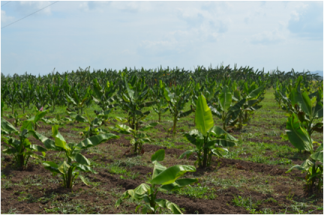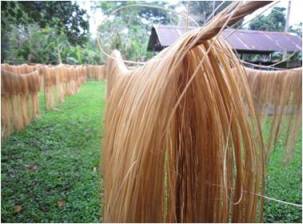The Philippines is the world’s top exporter of abaca, supplying 85% of the global abaca fiber production. The Philippine Abaca Industry earns US$80 million annually. However, viruses such as the Abaca Bunchy Top Virus (ABTV), mosaic, and bract mosaic have hindered the production of abaca in the country. In fact, in 2011, 19,000 ha of abaca were damaged by ABTV.
 To address this challenge, a project is aiming for the genetic improvement of abaca to improve yield and fiber quality. It is being undertaken in the project, Abaca Functional Genomics: High Throughput Discovery of Genes and Molecular Markers, which is being implemented by the Institute of Biological Sciences of the University of the Philippines Los Baños (UPLB). The project is funded by the Philippine Council for Agriculture, Aquatic and Natural Resources Research and Development of the Department of Science and Technology (DOST-PCAARRD).
To address this challenge, a project is aiming for the genetic improvement of abaca to improve yield and fiber quality. It is being undertaken in the project, Abaca Functional Genomics: High Throughput Discovery of Genes and Molecular Markers, which is being implemented by the Institute of Biological Sciences of the University of the Philippines Los Baños (UPLB). The project is funded by the Philippine Council for Agriculture, Aquatic and Natural Resources Research and Development of the Department of Science and Technology (DOST-PCAARRD).
The project examines the genetic, molecular, and biochemical mechanisms that supports important traits of abaca such as fiber quality and ABTV resistance. The method aims to develop molecular markers that would eventually lead to genetic improvement, which can raise yield and enhance fiber quality, resulting to the improvement of abaca farmers’ livelihood.
 Researchers are now testing and validating three genes that describe the mechanism of virus resistance of abaca line Back Cross 2 or BC2. These are the eukaryotic initiation factor 4G (eIF4G), proliferative cell nuclear antigen (PCNA), and retinoblastoma-related gene (RBR).
Researchers are now testing and validating three genes that describe the mechanism of virus resistance of abaca line Back Cross 2 or BC2. These are the eukaryotic initiation factor 4G (eIF4G), proliferative cell nuclear antigen (PCNA), and retinoblastoma-related gene (RBR).
This technology was featured in the 12th National Biotechnology Week (NBW), which was held at the Bureau of Soils and Water Management (BSWM) from November 21 to 25, 2016. It had the theme, Bioteknolohiya: Kaagapay sa Pangkalahatang Kaunlaran, and the tagline, Yakapin ang Pagbabago, Biotek na Tayo!
As part of DOST’s activities during the NBW, PCAARRD held a two-day agriculture and aqua science and technology (S&T) fora on November 22 and 24, respectively. Aside from the fora, the Council, along with other DOST agencies, showcased its biotechnology initiatives through an exhibit that was displayed at the BSWM grounds throughout the week.
